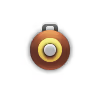


Bostwick's P-47M-1-RE was a P-47M-1-RE Thunderbolt belonging to US ace George Eugene Bostwick. Bostwick was born on 19th October 1919 in Eau Claire, Eau Claire County, Wisconsin. During his career he achieved eight confirmed, two probable and six destroyed aircraft on ground. His first victim was a Bf 109 over Grandevilliers, France, on 7th June 1944, a day after D-Day. On 4th July 1944, he scored three more Bf 109s and damaged one. Two days later he shot down another Bf 109. On 11th September 1944, while attacking Euskirchen airfield, he destroyed three Fw 190 fighters on the ground. His success led to him being promoted on 11th September 1944 to a rank of Captain. After his first tour of duty ended, he transferred to 63rd Fighter Squadron from his previous 62nd Fighter Squadron. On 25th March 1945, Bostwick became one of few allied pilots to shoot down a Me 262 Schwalbe jet fighter, near Köln. His last air to air victory was achieved over two Fw 190s over Bremen on 7th April 1945. Three days later he destroyed four aircraft on the ground at Werder airport. He achieved no further success. On 19th April 1945, Bostwick was promoted to a rank of Major, a month before his promotion he also became a commander of the 63rd Fighter Squadron. He retired from the air force in 1953 and died on 6th February 1990. The plane, nicknamed "Ugly Duckling", is painted after the camouflage scheme of Bostwick's P-47 while in the 56th Fighter Group.
Bostwick's P-47M-1-RE was introduced as a premium pack in Update 1.49 "Weapons of Victory". The P-47M is the fastest P-47 variant in the game. The engine features more horsepower than any of the P-47s found in the game, allowing it to climb faster to altitude or get away from unfavourable situations. Another feature not found on any other P-47 are the underwing dive brakes, allowing to slow down when going too fast, as the controls tend to stiffen when above 700 km/h.
Bostwick's P-47M-1-RE was discontinued after the 2020 May sale, but has since been made available either for purchase in the store or in-game with Golden Eagles for specific American mini-events like the 2020 "D-Day sale", the 2021 "US Air Force Day", the 2022 "US Air Force Birthday" and, most recently, the 2023 "US Air Force Birthday".
flaps
flaps
flaps
brake
| Belt | Belt filling | Armor penetration (mm) at a distance: | |||||
|---|---|---|---|---|---|---|---|
| 10 m | 100 m | 500 m | 1000 m | 1500 m | 2000 m | ||
| API-T/AP/AP/I | 30 | 27 | 20 | 13 | 9 | 6 | |
| AP-I/AP-I/API-T/I/I | 28 | 26 | 18 | 11 | 7 | 4 | |
| API-T/I/AP/AP/AP-I/AP-I | 30 | 27 | 20 | 13 | 9 | 6 | |
| API-T | 28 | 26 | 18 | 11 | 7 | 4 | |
| AP-I/I/AP-I/I | 28 | 26 | 18 | 11 | 7 | 4 | |
| Name | Weight | Slot | ||||||||||||
|---|---|---|---|---|---|---|---|---|---|---|---|---|---|---|
| 62.8 kg |  |  |  |  |  |  |  |  |  |  | ||||
| 117.9 kg |  |  |  | |||||||||||
| 242.6 kg |  |  |  | |||||||||||
| 500.8 kg |  |  | ||||||||||||







 2 x (100 / 235 / 495) %
2 x (100 / 235 / 495) % 
 2 x 178 %
2 x 178 % 

Flight performance | |
|---|---|
Survivability |
|---|
Weaponry | |
|---|---|
